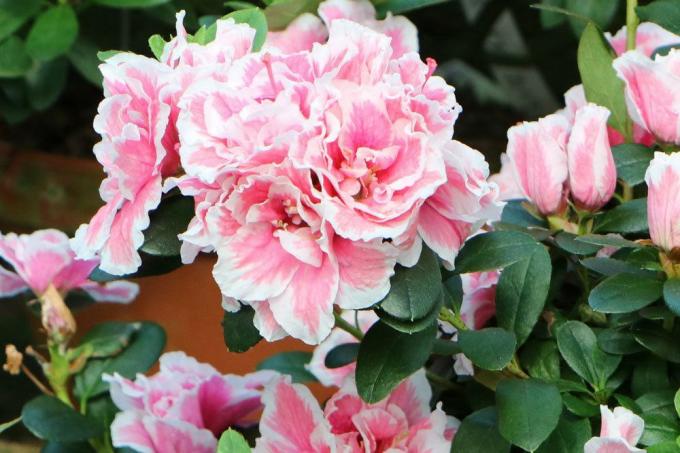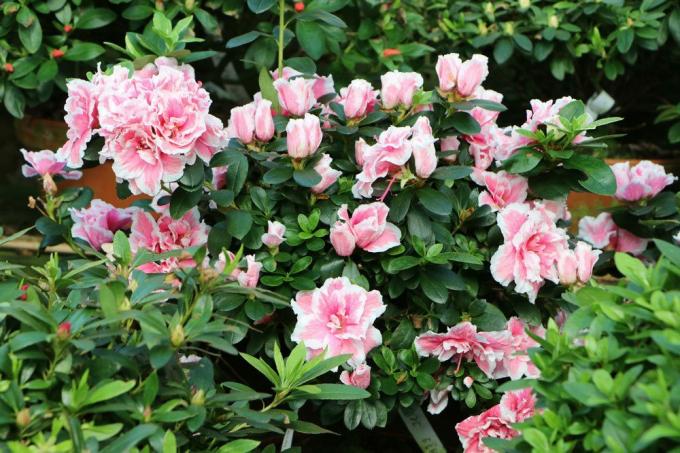
table of contents
- Cutting azaleas
- Remove withered
- Thinning
- Waiting time for topiary
- Radical cut
- Ideal cutting tool
- Stimulate branching
- Care after pruning
A young garden azalea drives out diligently and grows to a considerable size over the years. Your owner does not have to be a gifted cutter, it creates a beautiful crown all by itself. What remains are a few corrective interventions every now and then so that the annual sea of flowers takes on oceanic proportions. The cutting of the azalea not only has to be limited to what is necessary, but also has to be timed correctly.
Cutting azaleas
Even a garden shrub that is not regularly pruned by its owner can develop into a healthy plant. This includes the garden azalea, which can do without the intervention of the secateurs for its entire life. By nature, it forms a stable branch structure and does not require a structural cutout.
In addition to the healthy growth that every owner wants, there are also some self-serving expectations. The plant should always bloom profusely and form a well-formed, dense crown. But this can sometimes only be achieved with a cut back. Whenever one of these two points is endangered or can be optimized, scissors can be used.
Remove withered
With the garden azalea, there is a pruning measure that is regularly on the plan: the removal of withered flowers. No owner should do without this, even if he has the azalea otherwise allows it to grow freely.
- remove all dead flowers every year
- immediately after flowering
- within three weeks at the latest
The removal of the remnants of the flowers interrupts the further course of nature, which has now planned the seed formation. With the enormous number of flowers, seed formation would consume a huge portion of energy. Since the buds for the following year are formed around the same time, this process can benefit from the energy saved. In this way a profuse bloom is achieved.

tip: The withered flower parts can enrich the compost heap, provided the azalea is perfectly healthy.
Instructions for cleaning out
You can safely leave the secateurs in the shed for this activity. Your own ten fingers are the best tool, as the shoots can be broken off effortlessly. If you work with the "soft" fingers, you cannot cause any injuries to other parts of the plant if you touch the plant unavoidably. Especially the new, tender bud approaches are in the immediate vicinity and are still quite sensitive and.
- First, wash your hands thoroughly with soap so that no harmful germs from other gardening work adhere to them.
- Take a bucket that is big enough to collect faded.
- Take the short piece of shoot below the withered flower between your fingers.
- Remove the withered inflorescence by tilting the shoot to one side until it breaks off.
- Remove all dead flowers one after the other.
Since not all flowers wilt at the same time, cleaning out is not to be understood as a one-off action. During the flowering period, withered material should be snapped away at regular intervals. The advantage is also that the current bloom comes into its own, completely undisturbed by withered petals.
Thinning
The garden azalea needs plenty of light for its leaves and flowers. At the beginning of her life she does not have to complain about a lack of light, provided she has been given a suitable location. However, the older an azalea gets, the larger the part of it that is no longer supplied with sufficient light. Fresh twigs and leaves keep the sun out, much like a parasol. Some suitable cutting measures ensure that light reaches these areas better again.
- Thinning out shortly after flowering
- Remove dead branches
- Cut lightly leafy branches
- Tear off wild shoots close to the root neck
Regular lighting prevents baldness because more light enables new growth.
tip: If the azalea is growing too dense, cut individual shoots back to the lower-lying shoot every now and then.
Waiting time for topiary
A young garden azalea needs a long time to firmly conquer the ground with its roots. However, pruning is too much of a challenge to plant growth and should only be accompanied by roots that are strong in supply.
You should not cut a Japanese azalea in the first five years, as its root pressure is too weak for the hoped-for new growth. This waiver is not a disadvantage, because the young azalea usually has enough space to grow and is also well supplied with light. Their natural growth in these first years does not constitute an obstacle to a good crown structure.
Other varieties may be cut back to a third at a young age.
Topiary after flowering
The cut of a garden azalea can take on different dimensions. For some owners it is enough if the azalea has a harmonious crown structure. That requires a modest cut. Other owners, on the other hand, specifically shape their azaleas into geometric shapes, mostly spherical. The Japanese azaleas in particular are easy to cut and can be designed so easily.
- lay light pruning after flowering
- Remove individual branches that protrude unsightly from the crown

tip: You can use clippings that arise in summer for propagating cuttings.
Radical cut
If regular thinning and light shaped cuts are not enough to get a beautiful, leafy crown, a radical cut may be necessary. Over the years, its own foliage shadows parts of the crown, which consequently lose more and more leaves. The risk of baldness cannot always and not completely be countered with annual pruning measures.
In addition to the tapering cut, the strong shaped cut can also be viewed as a kind of radical cut, since almost all shoots are affected by the shortening.
time
If radical pruning is inevitable on your azalea, do not do it after flowering. Better to wait until spring, then the shrub will have the entire growing season ahead of it. He has enough time to recover from the cut. to drive out again. The accompanying weather provides the necessary warmth and light.
A radical cut also means that the following flowering season has to be canceled. The buds have fallen victim to the scissors and are no longer forming again for the current year.
Cut in several stages
Every cut means stress for the plant, because it has to adjust its growth accordingly and compensate for the "losses" as quickly as possible. So that the azalea is only challenged and not overwhelmed, the radical cut should be carefully considered. If the majority of the shoots fall victim to the scissors, the pruning measures should be spread over several years.
Instructions for radical cutting
When cutting, keep an eye on the structure of the crown of the azalea so that the desired shape automatically forms after it has sprouted.
Therefore, never shorten all the shoots at the same height.
- let young shoots stand
- old shoots to approx. Cut 30-40 cm
- Remove thin side branches directly on the main shoot
- Leave a 10 cm stub from larger branches
tip: Let the branch cones stand until the new shoots have developed strongly. The cones then usually fall off by themselves or can be cut back.
Ideal cutting tool
The mostly finger-thin branches of the garden azalea are easiest to remove with a pair of rose shears. Make sure that the blades are cleaned and disinfected before cutting. You will need to use a saw for thicker branches.
The tool should also be sharpened regularly, as blunt blades cause frayed cut surfaces. Such cut surfaces heal poorly and are ideal gateways for harmful germs. You should also seal larger wounds.
Stimulate branching
Removing fresh flower buds in spring can stimulate branching. However, for the current gardening year you have to forego the flowering entirely or be content with a light version. If this does not happen every year, the optical loss can be accepted in favor of a denser crown.
Care after pruning
After a large pruning, not only do the remaining branches get more sun, the root area has also largely lost its shade. To prevent this area from drying out, you should spread a thick layer of mulch over it.
The plant needs plenty of nutrients to sprout, which is why you should definitely provide it with an azalea fertilizer. Subsequently water your garden azalea depending on the weather. The top layer of soil should never dry out completely.
tip: If you radically prune an azalea, do not transplant it for the next two years. Otherwise, the desired new shoot may not take place.




